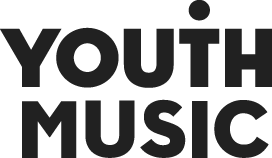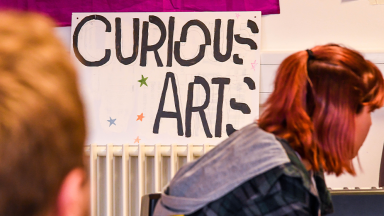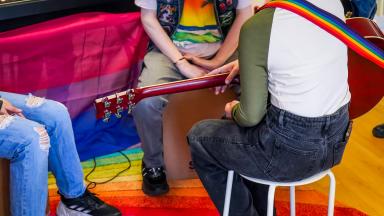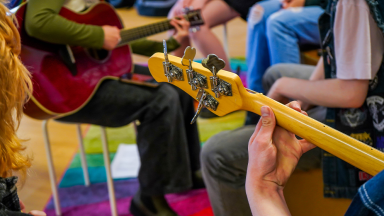Words by Youth Music NextGen writer, Erin Townsend | @erintownsendmusic
This LGBT+ History Month, Youth Music NextGen writer Erin Townsend dives into the paradox of queer visibility in music—where LGBTQ+ artists dominate the charts, yet still battle deep-rooted barriers, especially in classical music—and explores how musicians and advocates are reshaping the industry to be truly inclusive.
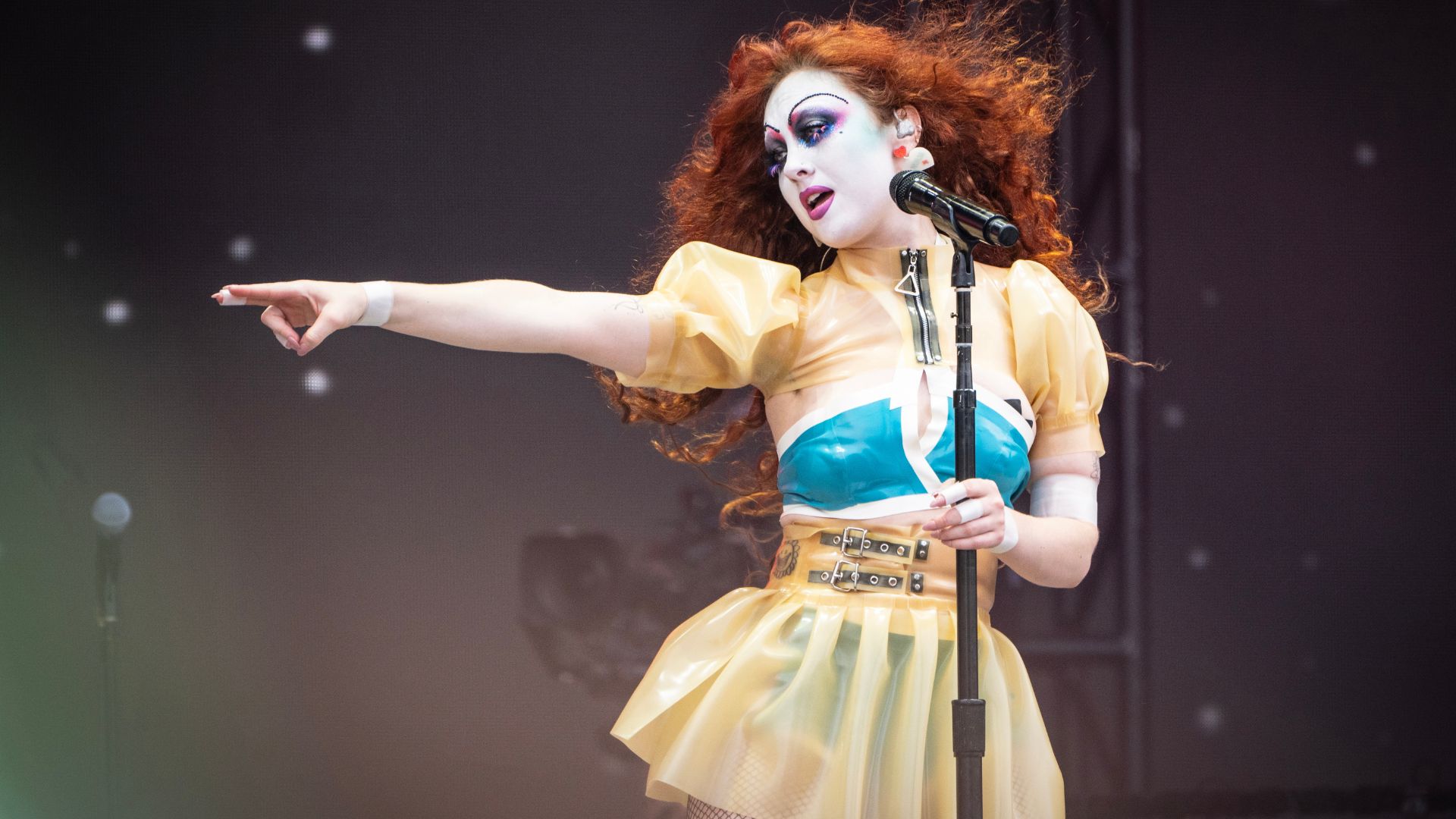
Given the state of popular music currently, one may think we are living in a utopian age for queer musicians. With artists such as Chappell Roan and Billie Eilish topping the charts, LGBTQ+ music is out in the mainstream louder and prouder than ever before. Yet the reality for young queer people is starkly different: many feel ostracised and often turn to music for support.
Trans youth, in particular, are facing a systematic withdrawal of their rights through the government’s ban on puberty blockers for under-18s and years-long waits for life-saving healthcare. In the US, the recent executive orders outright deny their existence. This contradiction raises an urgent question: why are queer people celebrated publicly in the music industry but still oppressed politically? And more importantly, what can be done to challenge this?
Classical Music and the Burden of Tradition
As a classical musician, I feel this contradiction even more keenly. Growing up in Brighton, I was surrounded by the unapologetic queer joy of the country’s gay capital, but this always felt somewhat at odds with the music we played in my youth orchestra. Although I had many queer friends who were classical musicians and even met my ex-girlfriend through orchestra, I never felt I could openly express myself through the music, nor did I find much to identify with in the pieces we played.
This disconnect can be traced back to the 19th-century institutionalisation of classical music. As Austro-German nationalism flourished, the values of patriarchy and heteronormativity became deeply embedded in the music and its surrounding discourse. These “masterworks” still dominate concert programming today, forming a canon that largely excludes the voices of women, the Global Majority, and LGBTQ+ composers.
Over recent years, there has been increasing awareness of the systemic disadvantages faced by female composers and uncovering of the hidden histories of Black classical music, yet queer histories in classical music remain largely overlooked.
Why is there so much less awareness around LGBTQ+ history, culture and contributions to the field? And how can we actively queer classical music to assert its radical potential?
I believe music’s role in society allows it to be a powerful vehicle for social change, and classical music is no exception. Yet the challenges of contemporary cultural politics and classical music’s complex legacy must be carefully considered to ensure this change is executed sensitively and effectively, rather than just reinforcing the heteropatriarchal status quo.
Queer Trailblazers in Classical Music History
My research into queer history has revealed many inspiring figures who challenge the archetypal perception of classical music.
- Ethel Smyth, who penned the anthem for women’s suffrage ‘March of the Women’, who may even have had a relationship with Emmeline Pankhurst.
- Bayard Rustin, the American civil rights activist and singer who kickstarted the early music revival of the 1950s and 60s.
- Julius Eastman, a Black queer composer, who wore his sexuality front and centre in writing avant-garde pieces like ‘Gay Guerilla’.
- Caroline Shaw, a Pulitzer prize-winning contemporary composer, who is now blending genres and styles with songwriting and improvisation in the new band she started with her partner, Ringdown.
- Wendy Carlos, a trans pioneer of electronic music who brought the synthesiser into the popular music mainstream, was equally a classical musician, shown by her seminal 1968 album Switched On Bach.
These musicians reassure me that there is a place for people like me in the world of classical music too. They show that queer people have always existed in the field and shaped its progress. Their work challenges us to rethink the genre’s boundaries and recognise its full spectrum of influences.
Queering Classical Music Through Programming and Performance
The contribution of cultural organisations to the increasing visibility of queerness must not be overlooked. Thoughtful programming can be used as a form of activism, something that I endeavour to practice in my work with the Alternative Canon Project. Founded by students, ACP seeks to highlight underrepresented and underperformed music through regular concerts, a resource library and our yearly RETUNE Festival. We seek to provide high-quality performances of pieces that have traditionally been excluded from the canon, reasserting their cultural and aesthetic value.
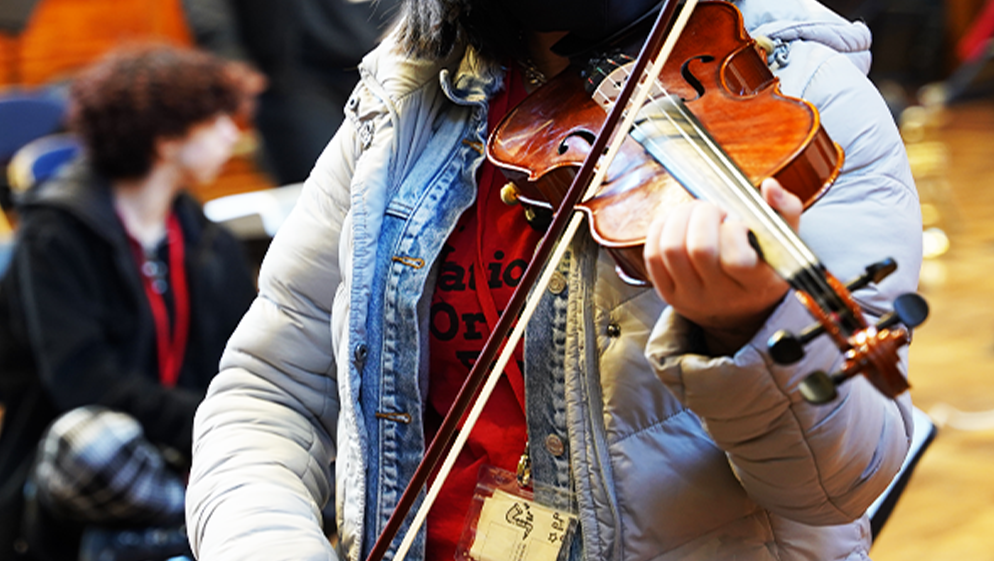
Founded by conductor Oliver Zeffman in 2023, Classical Pride platforms the contributions of LGBTQ+ people in classical music on a national level. It was the first Pride celebration ever by any major European symphony orchestra or concert hall. Last year, it expanded to a five-day festival with events ranging from choral to orchestral to drag performance, the finale of which I saw. It was a wonderful night with spectacular performances of Copland, Tchaikovsky, Szymanowski, Cassandra Miller and a new commission by Jake Heggie, all presented in an informative and accessible format by Nick Grimshaw. It went beyond mere tokenism to foster a genuinely inclusive attitude throughout the whole festival experience, from gender-neutral toilets to the inclusion of a community choir, a free concert in the Barbican foyer before to another earlier in the week spotlighting young professionals at the start of their careers. It was a brilliant example of queering the traditional classical music performance environment, clearly one that had been thought about in depth and executed with much attention to detail. Its radical queerness went beyond its progressive programming and overall conception of the event to incorporate a deep commitment to community and accessibility too.
Community Music: A Lifeline for Queer Youth
The need for visibility in classical music extends beyond elite institutions. It emphasises the importance of community music to the whole ecosystem, part of the same mission to emancipate classical music from the 19th-century ideological baggage that it still carries. Grassroots projects such as the Youth Music-funded Curious Arts show how transformative music can be for queer youth. Legal, psychological and medical support are vital, but so are artistic spaces where LGBTQ+ young people can connect, express themselves, and find belonging. These community interventions support queer kids socially and holistically.
The Future of Queer Inclusion in Classical Music
Queering classical music involves questioning the everyday systems that we take for granted in society and challenging ourselves to strive for greater equality, inclusivity, kindness and community. It must be intersectional, addressing inequalities of other marginalised groups of gender, race, class, and disability.
With careful thought and authentic commitment, classical music can evolve into a space where queer voices are as visible as they are now in pop. Current questions around access and equality, diversity and inclusion in the industry must be tackled sensitively and professionally. Yet the progress made by organisations, composers, and advocates, offers hope that change is not only possible – it’s already happening.
Read next...
Curious Arts – Empowering LGBTQIA+ Youth through Music
Curious Youth Music by Curious Arts is a Trailblazer Fund project that's about building community, encouraging expression, and giving LGBTQIA+ young people a safe space to make music in Newcastle.
Queering the Music Room: Building Inclusive Spaces for the Next Generation
NextGen writer and freelance arts educator, Maisy Neale, explores the vital role of musicians and educators in fostering LGBTQIA+ inclusion, highlighting the challenges in education policy and the need for a more diverse, affirming music curriculum.
Tuning into Identity: Music's Role in LGBTQIA+ Self-Exploration
Youth Music NextGen writer, David Simkins, examines the importance of queer representation and identification in music for young people.
